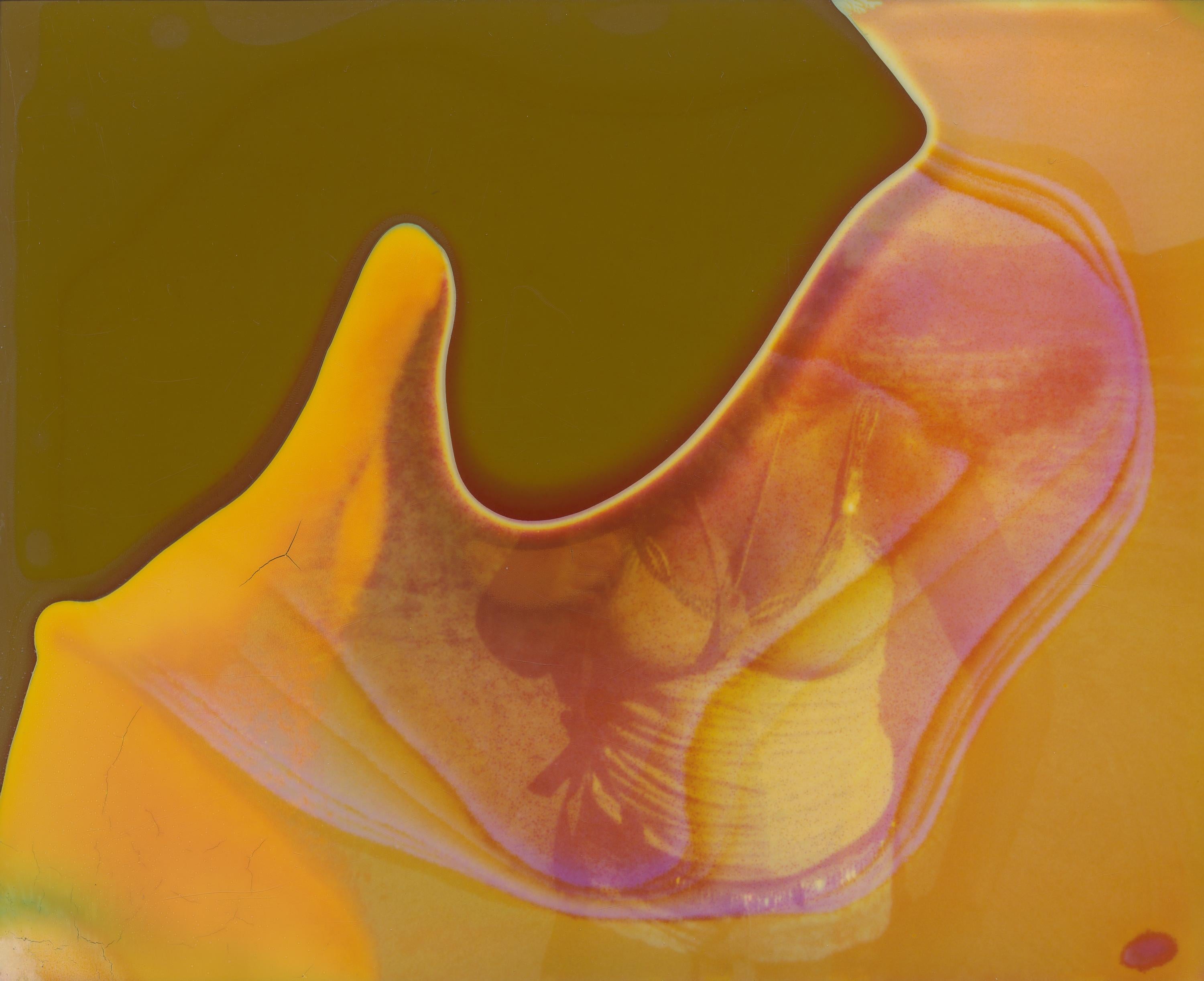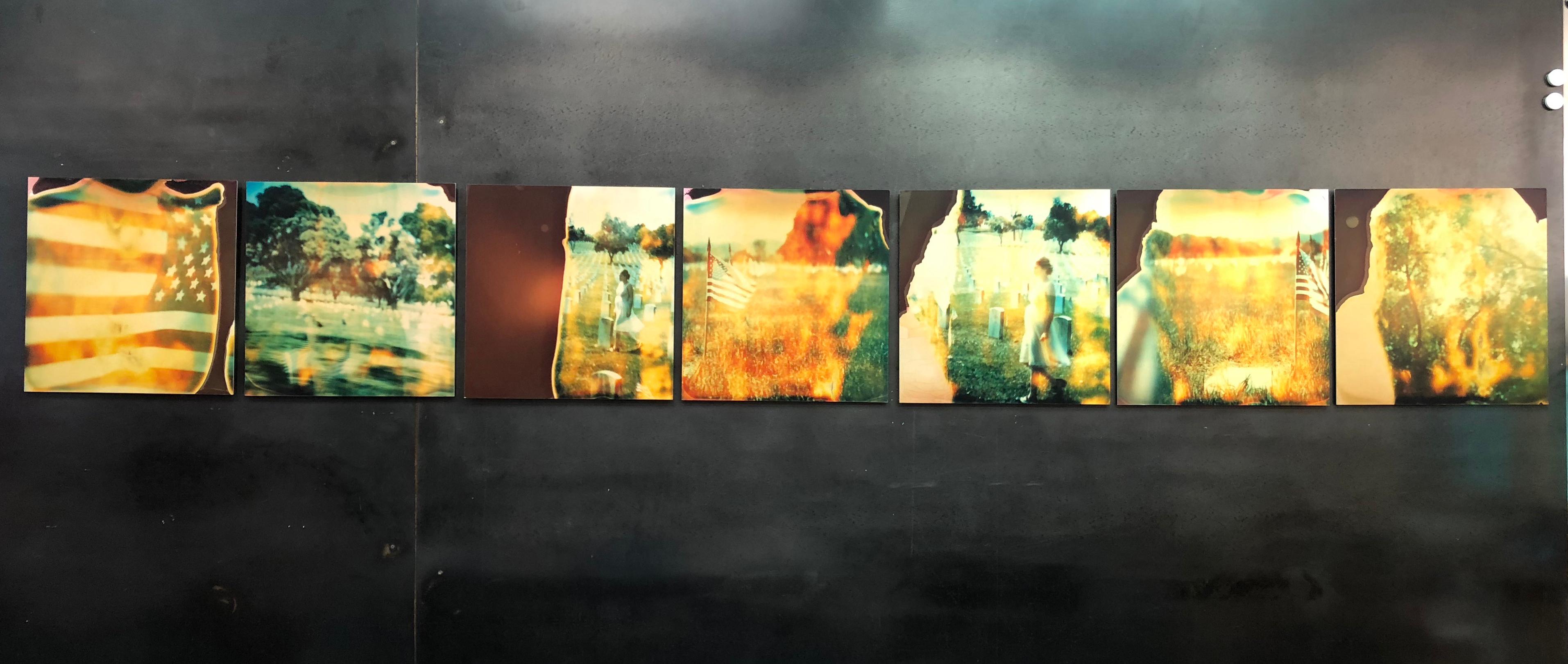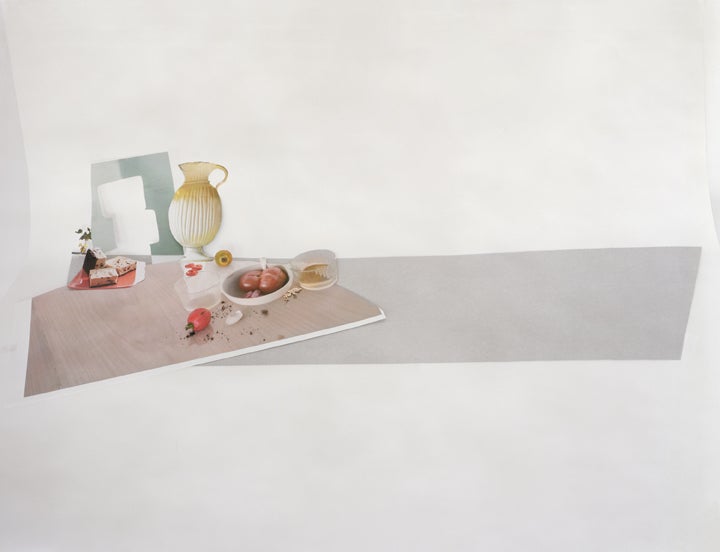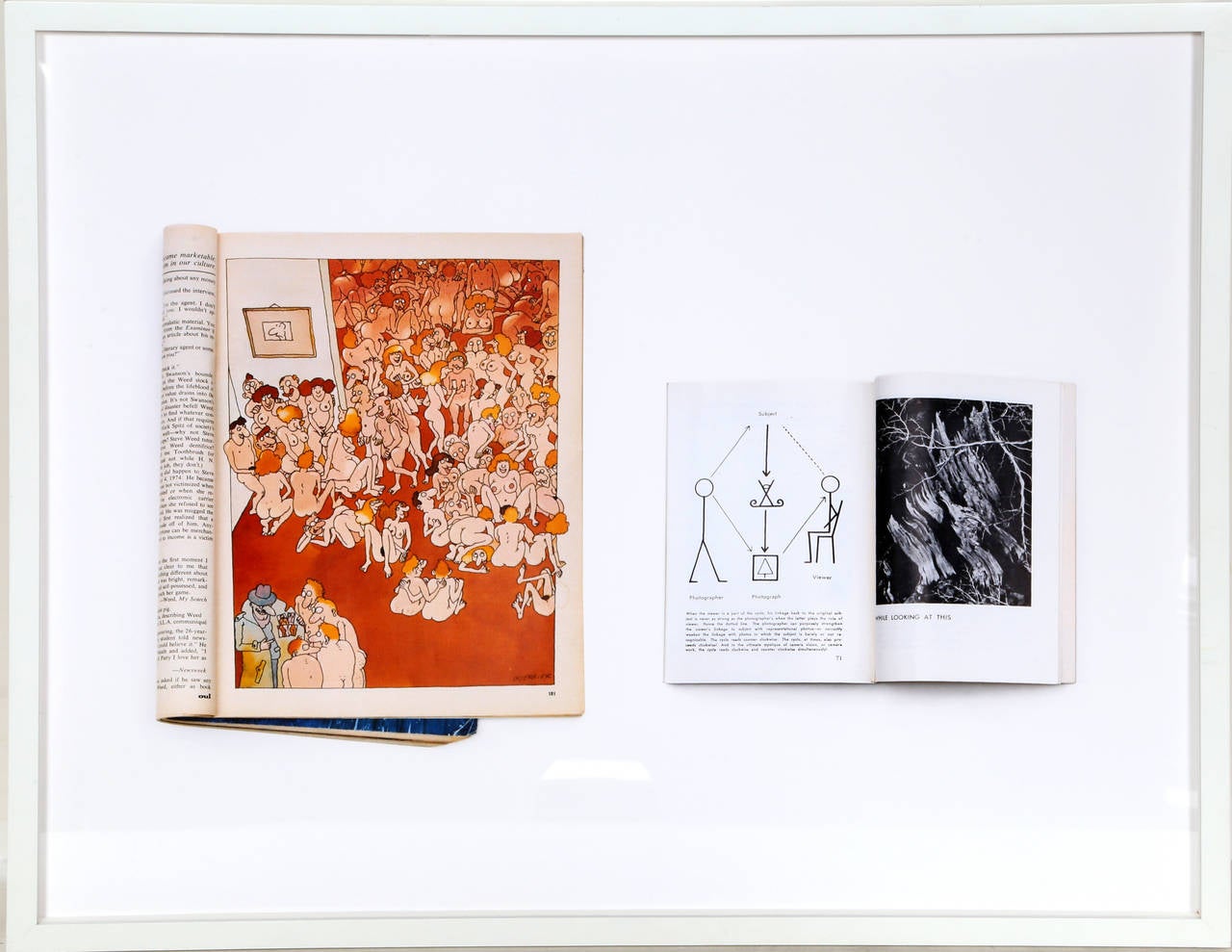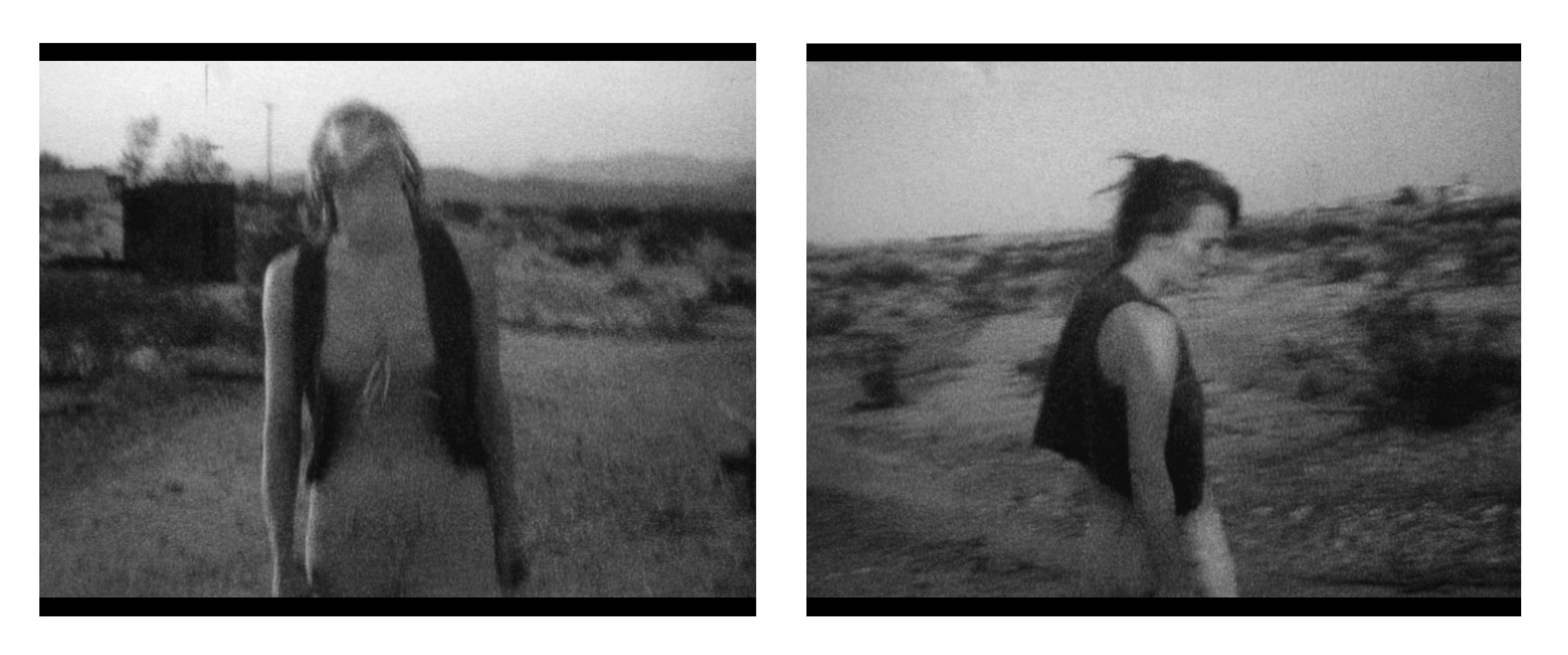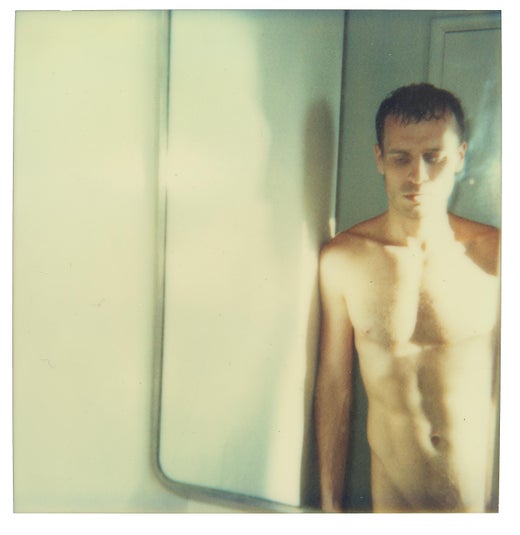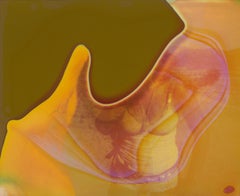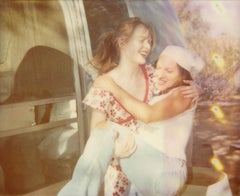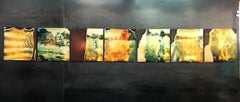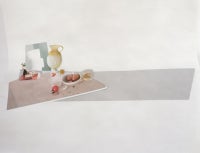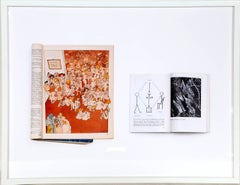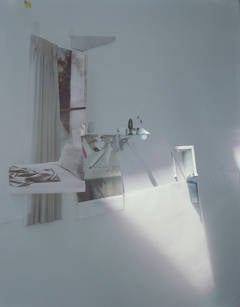Items Similar to Moving in Together (Till Death do us Part) - analog, mounted, Installation
Want more images or videos?
Request additional images or videos from the seller
1 of 14
Stefanie SchneiderMoving in Together (Till Death do us Part) - analog, mounted, Installation2008
2008
$55,000
£42,830.33
€48,719.37
CA$79,209.16
A$86,922.18
CHF 45,399.88
MX$1,039,251.21
NOK 575,069.88
SEK 536,360.88
DKK 363,865.44
About the Item
Moving in Together (Till Death do us Part) - Installation - 2008
Edition of 5.
16 analog C-Prints , hand-printed by the artist on Fuji Crystal Archive Paper, based on 13 Polaroids,
Mounted on Aluminum with matte UV-Protection.
15 x pieces 50x60cm. 1 x 125x156cm. Installed 160 x 650 cm.
Artist Inventory No. 8533.01.
Signed on verso.
Included is the song "Million Pieces" by Daisy McCrackin.
Poems written by Austen Tate.
Stefanie Schneider’s work is a meditation on time—its erosion, its persistence, its ability to fracture and reassemble in the mind’s eye. Like faded dreams or half-remembered encounters, her Polaroid images exist in a liminal space where past and present bleed into one another, never quite whole, never truly lost.
Her process itself is an act of defying time. The expired Polaroid film she employs carries within it the chemical scars of its own history, yielding unpredictable mutations that transform each image into an artifact of imperfection. These distortions are not merely aesthetic choices but echoes of memory—relics of moments that refuse to remain static. In an era of hyper-clarity and digital perfection, Schneider’s art invites us to embrace the ephemeral, to find beauty in the decayed and the transient.
The American West, a landscape steeped in myth and reinvention, becomes the perfect backdrop for this exploration of time’s paradoxes. Her subjects—wandering figures in motels, trailer parks, and endless deserts—are suspended between nostalgia and an uncertain future, much like the film she captures them on. They exist in a cinematic loop, their stories unfolding and dissolving, caught in the glow of a setting sun that never fully disappears.
But there is a deeper shift at play, one that mirrors the changing nature of artistic life itself. Before 2020, artists thrived on movement, on exposure, on a constant dialogue between places and people. Travel was a necessity, a lifeline to new influences and inspirations. Yet, in the wake of global upheaval, a hyper-isolationist existence has taken hold, where the act of creation unfolds within a contained world. Schneider’s desert sanctuary reflects this new reality—an alternate universe born from necessity, a space where time stretches and bends inward, echoing the dreamlike qualities of her work. The outside world receded, but within this solitude, another form of freedom emerged: the ability to construct a world entirely of one’s own making.
Memory, like Schneider’s images, is imperfect. It shifts, it fades, it distorts. Yet, in these imperfections, new narratives emerge—ones that feel more real than reality itself. This is the power of Schneider’s work: to remind us that time is not linear but layered, that the past is never truly past, and that every moment carries the weight of all that came before.
Her work is not just a preservation of a vanishing medium—it is a meditation on the nature of remembrance itself. In every blurred silhouette and chemical wash of color, she captures what it means to hold onto time even as it slips through our fingers, to relive and reinterpret, over and over again, the memories we think define us. Schneider’s images are time capsules, not of fixed moments, but of the way moments feel—a testament to how time warps, erases, and ultimately reveals. They are not just photographs; they are fragments of time, unraveling like film caught in the projector’s glow, forever flickering between memory and dream.
Stefanie Schneider received her MFA in Communication Design at the Folkwang Schule Essen, Germany. Her work has been shown at the Museum for Photography, Braunschweig, Museum für Kommunikation, Berlin, the Institut für Neue Medien, Frankfurt, the Nassauischer Kunstverein, Wiesbaden, Kunstverein Bielefeld, Museum für Moderne Kunst Passau, Les Rencontres d'Arles, Foto -Triennale Esslingen.
- Creator:Stefanie Schneider (1968, German)
- Creation Year:2008
- Dimensions:Height: 63 in (160 cm)Width: 255.91 in (650 cm)Depth: 0.4 in (1 cm)
- Medium:
- Movement & Style:
- Period:
- Condition:
- Gallery Location:Morongo Valley, CA
- Reference Number:1stDibs: LU652316074682
Stefanie Schneider
Stefanie Schneider received her MFA in Communication Design at the Folkwang Schule Essen, Germany. Her work has been shown at the Museum for Photography, Braunschweig, Museum für Kommunikation, Berlin, the Institut für Neue Medien, Frankfurt, the Nassauischer Kunstverein, Wiesbaden, Kunstverein Bielefeld, Museum für Moderne Kunst Passau, Les Rencontres d'Arles, Foto -Triennale Esslingen., Bombay Beach Biennale 2018, 2019.
About the Seller
4.9
Platinum Seller
Premium sellers with a 4.7+ rating and 24-hour response times
Established in 1996
1stDibs seller since 2017
1,050 sales on 1stDibs
Typical response time: 1 hour
- ShippingRetrieving quote...Shipping from: Morongo Valley, CA
- Return Policy
More From This Seller
View AllLiving in a Dream (Till Death do us Part) - Contemporary, Polaroid, Women
By Stefanie Schneider
Located in Morongo Valley, CA
Living in a Dream (Till Death do us Part) - 2005
20x20cm,
Edition of 10,
Archival C-Print print, based on the Polaroid.
Certificate and Signature label, artist Inventory No. 9781.
Not mounted.
on offer is a piece from the movie "Till Death do us Part"
Stefanie Schneider’s Till Death Do Us Part
or “There is Only the Desert for You.”
BY DREW HAMMOND
Stefanie Schneider’s Til Death to Us Part is a love narrative that comprises three elements:
1.
A montage of still images shot and elaborated by means of her signature technique of using Polaroid formats with outdated and degraded film stock in natural light, with the resulting im ages rephotographed (by other means) enlarged and printed in such a way as to generate further distortions of the image.
2.
Dated Super 8 film footage without a sound track and developed by the artist.
3.
Recorded off-screen narration of texts written by the actors or photographic subjects, and selected by the artist.
At the outset, this method presupposes a tension between still and moving image; between the conventions about the juxtaposition of such images in a moving image presentation; and, and a further tension between the work’s juxtaposition of sound and image, and the conventional relationship between sound and image that occurs in the majority of films. But Till Death Do Us Part also conduces to an implied synthesis of still and moving image by the manner in which the artist edits or cuts the work.
First, she imposes a rigorous criterion of selection, whether to render a section as a still or moving image. The predominance of still images is neither an arbitrary residue of her background as a still photographer—in fact she has years of background in film projects; nor is it a capricious reaction against moving picture convention that demands more moving images than stills. Instead, the number of still images has a direct thematic relation to the fabric of the love story in the following sense. Stills, by definition, have a very different relationship to time than do moving images. The unedited moving shot occurs in real time, and the edited moving shot, despite its artificial rendering of time, all too 2009often affords the viewer an even greater illusion of experiencing reality as it unfolds. It is self-evident that moving images overtly mimic the temporal dynamic of reality.
Frozen in time—at least overtly—still photographic images pose a radical tension with real time. This tension is all the more heightened by their “real” content, by the recording aspect of their constitution. But precisely because they seem to suspend time, they more naturally evoke a sense of the past and of its inherent nostalgia. In this way, they are often more readily evocative of other states of experience of the real, if we properly include in the real our own experience of the past through memory, and its inherent emotions.
This attribute of stills is the real criterion of their selection in Til Death Do Us Part where consistently, the artist associates them with desire, dream, memory, passion, and the ensemble of mental states that accompany a love relationship in its nascent, mature, and declining aspects.
A SYNTHESIS OF MOVING AND STILL IMAGES BOTH FORMAL AND CONCEPTUAL
It is noteworthy that, after a transition from a still image to a moving image, as soon as the viewer expects the movement to continue, there is a “logical” cut that we expect to result in another moving image, not only because of its mise en scène, but also because of its implicit respect of traditional rules of film editing, its planarity, its sight line, its treatment of 3D space—all these lead us to expect that the successive shot, as it is revealed, is bound to be another moving image. But contrary to our expectation, and in delayed reaction, we are startled to find that it is another still image.
One effect of this technique is to reinforce the tension between still and moving image by means of surprise. But in another sense, the technique reminds us that, in film, the moving image is also a succession of stills that only generate an illusion of movement. Although it is a fact that here the artist employs Super 8 footage, in principle, even were the moving images shot with video, the fact would remain since video images are all reducible to a series of discrete still images no matter how “seamless” the transitions between them.
Yet a third effect of the technique has to do with its temporal implication. Often art aspires to conflate or otherwise distort time. Here, instead, the juxtaposition poses a tension between two times: the “real time” of the moving image that is by definition associated with reality in its temporal aspect; and the “frozen time” of the still image associated with an altered sense of time in memory and fantasy of the object of desire—not to mention the unreal time of the sense of the monopolization of the gaze conventionally attributed to the photographic medium, but which here is associated as much with the yearning narrator as it is with the viewer.
In this way, the work establishes and juxtaposes two times for two levels of consciousness, both for the narrator of the story and, implicitly, for the viewer:
A) the immediate experience of reality, and
B) the background of reflective effects of reality, such as dream, memory, fantasy, and their inherent compounding of past and present emotions.
In addition, the piece advances in the direction of a Gesammtkunstwerk, but in a way that reconsiders this synaesthesia as a unified complex of genres—not only because it uses new media that did not exist when the idea was first enunciated in Wagner’s time, but also because it comprises elements that are not entirely of one artist’s making, but which are subsumed by the work overall. The totality remains the vision of one artist.
In this sense, Till Death Do Us Part reveals a further tension between the central intelligence of the artist and the products of other individual participants. This tension is compounded to the degree that the characters’ attributes and narrated statements are part fiction and part reality, part themselves, and part their characters. But Stefanie Schneider is the one who assembles, organizes, and selects them all.
THE RELATIONSHIP BETWEEN THIS IDEA (above) AND PHOTOGRAPHY
This selective aspect of the work is an expansion of idea of the act of photography in which the artistic photographer selects that which is already there, and then, by distortion, definition or delimitation, compositional and lighting emphasis, and by a host of other techniques, subsumes that which is already there to transform it into an image of the artist’s contrivance, one that is no less of the artist’s making than a work in any other medium, but which is distinct from many traditional media (such as painting) in that it retains an evocation of the tension between what is already there and what is of the artist’s making. Should it fail to achieve this, it remains, to that degree, mere illustration to which aesthetic technique has been applied with greater or lesser skill.
The way Til Death Do Us Part expands this basic principle of the photographic act, is to apply it to further existing elements, and, similarly, to transform them. These additional existing elements include written or improvised pieces narrated by their authors in a way that shifts between their own identities and the identities of fictional characters. Such characters derive partially from their own identities by making use of real or imagined memories, dreams, fears of the future, genuine impressions, and emotional responses to unexpected or even banal events. There is also music, with voice and instrumental accompaniment. The music slips between integration with the narrative voices and disjunction, between consistency and tension. At times it would direct the mood, and at other times it would disrupt.
Despite that much of this material is made by others, it becomes, like the reality that is the raw material of an art photo, subsumed and transformed by the overall aesthetic act of the manner of its selection, distortion, organization, duration, and emotional effect.
* * *
David Lean was fond of saying that a love story is most effective in a squalid visual environment. In Til Death Do Us Part, the squalor of the American desert...
Category
Early 2000s Contemporary Color Photography
Materials
Archival Paper, Photographic Paper, C Print, Color, Polaroid
Moving in Together (Till Death do us Part) - analog, Contemporary, mounted
By Stefanie Schneider
Located in Morongo Valley, CA
Moving in Together (Till Death do us Part) - 2008
125x154cm,
Edition 1/5.
Analog C-Print, hand-printed by the artist on Fuji Crystal Archive Paper, based on the Polaroid.
Certifi...
Category
Early 2000s Contemporary Color Photography
Materials
Metal
Memorial Day (Stranger than Paradise) - analog, mounted, 7 pieces, 48x352cm
By Stefanie Schneider
Located in Morongo Valley, CA
Memorial Day (Stranger than Paradise) - 2001
Edition of 5,
48x46 cm each, installed 48 x 352cm including gaps.
7 analog C-Prints, hand-printed by the artist on Fuji Crystal Archiv...
Category
Early 2000s Contemporary Color Photography
Materials
Metal
Like the Wind II (Till Death Do Us Part) - incl. the book A HALF FORGOTTEN DREAM
By Stefanie Schneider
Located in Morongo Valley, CA
Like the Wind II (Till Death Do Us Part) - 2008
23x53.5cm,
Edition of 10, plus 2 Artist Proofs.
Archival C-Print, based on the 2 original Super-8 Stills.
Certificate and Signatur...
Category
Early 2000s Contemporary Color Photography
Materials
Archival Paper, Photographic Paper, C Print, Color, Polaroid
In Other Words (Till Death do us Part)
By Stefanie Schneider
Located in Morongo Valley, CA
In Other Words (Till Death do us Part) - 2005
20x24cm,
Edition of 10 plus 2 Artist Proofs.
Archival C-Print, based on a Polaroid.
Certificate and Signature label.
Artist Invent...
Category
Early 2000s Contemporary Color Photography
Materials
Archival Paper, Photographic Paper, C Print, Color, Polaroid
Moving in Together (Till Death.) - including the book 'A Half Forgotten Dream'
By Stefanie Schneider
Located in Morongo Valley, CA
Moving in Together (Till Death Do Us Part) - 2005
Including Stefanie Schneider's new monograph "A Half Forgotten Dream" signed. 192 pages, hardcover, published by Snap Collective, 2...
Category
Early 2000s Contemporary Color Photography
Materials
Archival Paper, Photographic Paper, C Print, Color, Polaroid
You May Also Like
Untitled #27
By Laura Letinsky
Located in New York, NY
From IV&IF
Price Upon Request
Untitled (Orgy), Digital Pigment Print by Peter Coffin
By Peter Coffin
Located in Long Island City, NY
A digital c-print by Peter Coffin. A conceptual work featuring a diptych of two pages from open books referring to the degrees of separation within the relationship between artist, a...
Category
Early 2000s Conceptual Color Photography
Materials
Digital Pigment
To want for nothing, #2
By Laura Letinsky
Located in New York, NY
To want for nothing, #2
Materials
Archival Pigment
Price Upon Request
Untitled #20
By Laura Letinsky
Located in New York, NY
from the series "Ill Form and Void Full"
Category
21st Century and Contemporary Photography
Price Upon Request
Untitled #29
By Laura Letinsky
Located in New York, NY
from the series "Ill Form and Void Full"
Ed. of 9
Price Upon Request
Patrick McMullan C-Prints, Set of 5
Located in Lake Worth Beach, FL
Artist/Designer; Manufacturer: Patrick McMullan (American, b. 1956)
Marking(s); notes: marking(s)
Materials: chromogenic print
Dimensions (H, W, D): largest (sight): 15.5"h, 23.5"w; ...
Category
20th Century Contemporary Portrait Photography
Materials
C Print
More Ways To Browse
Vintage Bird Hood Ornaments
Wang Qingsong
Warhol Maurice
Xavier Samre
Face Picasso
Folio Set
Hebrew Art
Interactive Sculpture
Jason Gray
La Lune
Large Vintage Framed Print
Manuel Artist
Original Lithographs Advertising
Pablo Picasso Lithograph Black And White
Paintings By Thomas King Original
Small Dolls
Texas Sculpture
Tobey Mark
